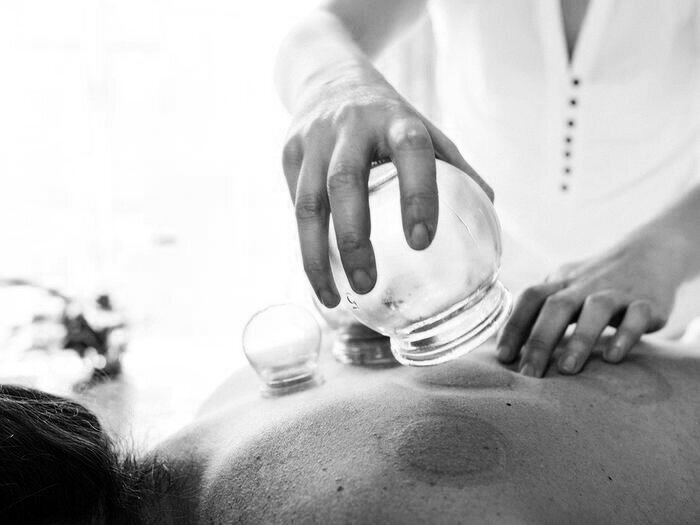BY MEGAN FLYNN, PT & DPT.
Cupping originated as a traditional, holistic Eastern Chinese medicine approach to muscle recovery and healing in which the goal was to balance the “qi” in the body as well as the “yin and yang” (positive and negative). However, more recently it has grown in popularity among a wide variety of athletes. In Western medicine, the cupping technique is described as creating a negative pressure to increase blood flow to the targeted skeletal muscles. Negative pressure is used to physically pull the soft tissue. This results in improved regional blood oxygen levels, thus clearing metabolic contaminants and resulting in improved muscle recovery and reduced pain.
There are different types of cupping, which can be classified by the type of cup, the purpose of the intervention, and the type of suction used. The three most common types of cupping are:
- Wet Cupping: This uses suction to draw blood out of the skin through small incisions.
- Dry Cupping: This is the most common form of cupping utilized in the United States. This uses a rubber or plastic suction cup applied to the skin to increase blood flow and circulation.
- Fire Cupping: This uses glass suction cups and fire to create a suction on the skin
In this blog, the focus is going to be on dry cupping, as this is the most utilized and relevant form of cupping in the running population. Dry cupping is done by applying plastic or rubber suction cups directly to the skin over the affected area. Multiple cups can be applied at the same time directly to painful or stiff areas and can remain on the skin for 5-20 minutes. Lotion might be used in order to easily glide the cups for a deep tissue massage technique. When the cups are removed, the skin underneath the cups is typically red due to the negative pressure and increased blood flow to the localized area.
Range of motion exercises are commonly incorporated while the cups are applied to further improve soft tissue mobility. For example, if the cups are applied to the calf, the clinician may ask the individual to move through a specific ankle range of motion alternating between dorsiflexion (pointing your toes up) and plantarflexion (pointing your toes away from you). Multiple cups can be applied at a time directly to painful or stiff areas and can remain on the skin for 5-20 minutes. When the cups are removed, the skin underneath the cups is typically red due to the negative pressure and increased blood flow to the localized area.
The benefits of dry cupping include reduced pain and inflammation, sedation of the nervous system, increased circulation to the treated area, softening of adhesions and stiff connective tissue, draining of toxins and waste from the lymphatic system, and the ability to affect deeper muscles and other soft tissue structures. Ullah et. al (2007) showed that cupping therapy used with anterior knee pain resulted in significant improvements in passive and active range of motion as well as a reduction in pain. In addition, Kim et al. showed that cupping therapy not only improved the range of motion but also increased nerve conduction of the treated muscles.
Overall, cupping is an effective alternative treatment to utilize in conjunction with physical therapy treatment to promote improved muscle recovery. Next time you have a nagging soreness or muscle tightness, ask your physical therapist or athletic trainer if cupping could be an effective modality to improve your pain!
Sources: Antush, Maximilian, “Effect of Cupping Therapy on Respiratory Gas Exchange in Trained Endurance Runners” (2019). WWU Graduate School Collection. 914.Kim, J., Cho, J., Do, K., Lim, S., Kim, H., and Yim, J. (2017)
Effect of cupping therapy on a range of motion, pain threshold, and muscle activity of the hamstring muscle compared to passive stretching. Journal of The Korean Society of Physical Medicine 12(3), 23-32.Rozenfeld, Evgeni, and Leonid Kalichman.
“New Is the Well-Forgotten Old: The Use of Dry Cupping in Musculoskeletal Medicine.” Journal of Bodywork and Movement Therapies, vol. 20, no. 1, Jan. 2016, pp. 173–178. Ullah, K., Younis, A., and Wali, M. (2007)
An investigation into the effect of cupping therapy as a treatment for anterior knee pain and its potential role in health promotion. The Internet Journal of Alternative Medicine 4(1), 1-15.

